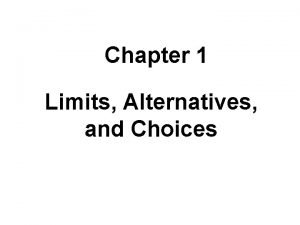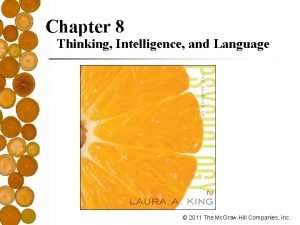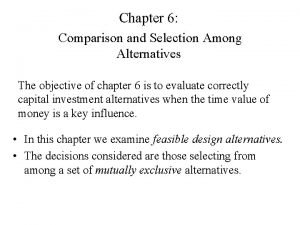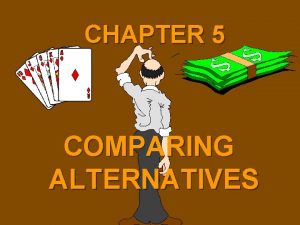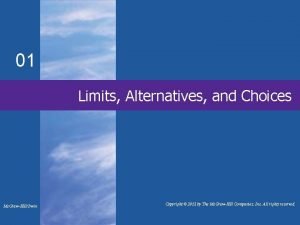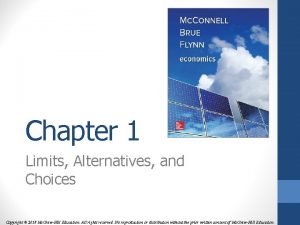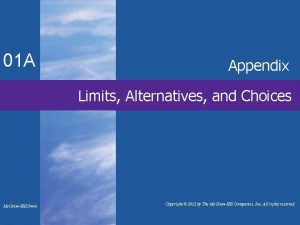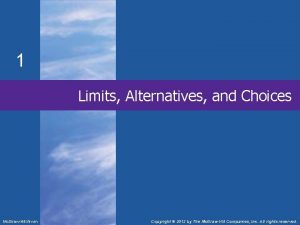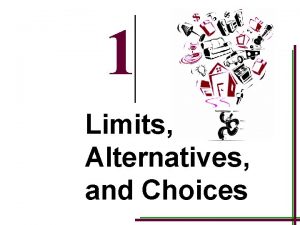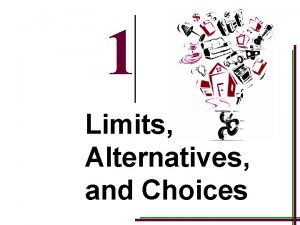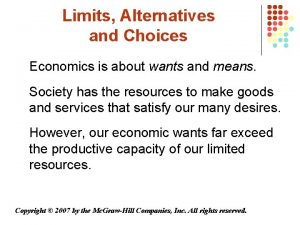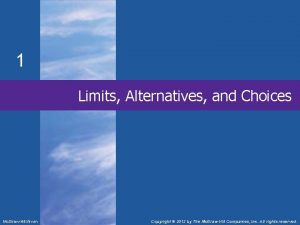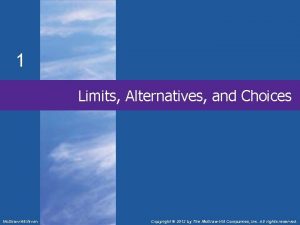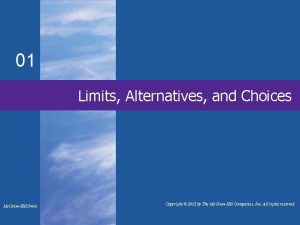LIMITS ALTERNATIVES AND CHOICES ACTIVITY 1 Your first




















- Slides: 20

LIMITS, ALTERNATIVES AND CHOICES

ACTIVITY 1 • Your first assignment: • If you had $1 billion, what would you do with it? Be as specific as possible.

SCARCITY (Scarce Resources) • limited amount of resources that are never sufficient to satisfy people’s virtually unlimited economic wants • Limited resources, unlimited wants

MARGINAL • In economics, this means “extra, ” “additional, ” “next” or “change in”

OPPORTUNITY COST • For every decision, you must give up the opportunity of getting the next best alternative • Ex- studying for a test rather than going to the movies or a concert • ***No such thing as a free lunch

UTILITY • The pleasure, happiness or satisfaction obtained from consuming a good or service • Measured by the imaginary unit of “utils” • ***economists assume that people act rationally when making decisions in order to maximize utility

LAW OF DIMINISHING MARGINAL UTILITY • At some point, with each additional unit consumed, the individual will receive less and less satisfaction • Very subjective

MARGINAL ANALYSIS • Comparison of marginal benefits and marginal costs in order to make decisions • Ex- Should you attend college? Should a business expand production? Should the government increase its defense program? • Continue until MB > MC

DEMAND • Shows how much of a product that consumers are willing and able to purchase at each of a series of possible prices at a specified period of time

QUANTITY DEMANDED • The amount of a good or service that buyer(s) want to purchase at a particular price during some time period

LAW OF DEMAND • As price falls, the quantity demanded rises, and as the price rises, the quantity demanded falls. • ***inverse relationship between price and quantity demanded

INDIVIDUAL DEMAND Remember - Demand goes Down P 6 Individual Demand Qd $5 10 4 20 3 35 2 55 1 80 Price (per bushel) P 5 4 3 2 1 0 D 10 20 30 40 50 60 70 80 Quantity Demanded (bushels per week) Q

SUBSTITUTE GOODS • one that can be used in place of another good • An increase in the price of one good will increase the demand of its substitutes and vice versa

COMPLEMENTARY GOODS • One good that is used together with another good • If the price of one goes up, the demand for the complement will decline and vice versa • Ex- Peanut butter and Jelly, tuition and textbooks

DETERMINANTS OF DEMAND • • • Changes In: TRIBE T- Tastes and preferences R- Related Goods’ Price I- Income of Buyers B- Buyers (the # of) E- Expectations of the Future

AC/DC Econ Video - DEMAND • https: //www. youtube. com/watch? v=Lw. Lh 6 ax 0 z. TE

LAW OF SUPPLY • As prices rise, the quantity supplied rises… as prices fall, the quantity supplied falls • Direct relationship between price and quantity supplied

DETERMINANTS OF SUPPLY • R- Resource Prices- Inputs that go into making a g/s • O- Other Goods’ Prices - Substitutes (milk/cheese) in production and joint products (mulch/lumber) • T- Taxes and Subsidies • T – Technology Change- increased/decreased efficiency • E- Expectations of Suppliers- expect. of future prices • N- Number of Sellers- more suppliers = higher S

EQUILIBRIUM PRICE • The price where the intentions of buyers and sellers meet • Quantity Demanded = Quantity Supplied

ACDC Supply and Demand Shifts • https: //www. youtube. com/watch? v=V 0 t. IOq U 7 m-c
 Economizing problem definition
Economizing problem definition Ap psychology thinking language and intelligence
Ap psychology thinking language and intelligence Evaluating alternatives and making choices among them
Evaluating alternatives and making choices among them Chapter 8 thinking language and intelligence
Chapter 8 thinking language and intelligence Limit involving infinity
Limit involving infinity Histogram polygon graph
Histogram polygon graph The limits of objective activity
The limits of objective activity Activity 4 look at the pictures
Activity 4 look at the pictures Explain how job choices affect income
Explain how job choices affect income Factors that affect your food choices
Factors that affect your food choices Activity coefficient
Activity coefficient Give us your hungry your tired your poor
Give us your hungry your tired your poor Family of orientation
Family of orientation Marriages and families changes choices and constraints
Marriages and families changes choices and constraints Reactants products and leftovers
Reactants products and leftovers Aoa aon diagram
Aoa aon diagram Activity 1 introductory activity
Activity 1 introductory activity Activity 1 activity 2
Activity 1 activity 2 Activity 3 explore me more
Activity 3 explore me more 1index
1index Comparison and selection among alternatives
Comparison and selection among alternatives
